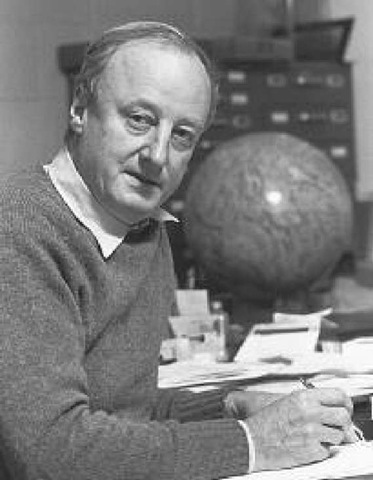(1928- ) Australian Economic Geologist, Geochemist
Most miners just want to get their ore out of the ground and the public just wants the ore or products made from it. However, there is a whole science of economic geology to study ore genesis and Brian Skinner is one of the true pioneers. Whereas many of the geochemists, petrologists, and mineralogists study the major and accessory rock-forming minerals and their relations, Skinner applied the latest in theories and experimental and analytical techniques to genesis of ore and surrounding gangue minerals. He first worked on volume properties of minerals but also added new information to the science on the behavior of rocks at high temperatures. One of his main interests, however, is sulfide minerals of which he is among the foremost experts. Using innovative experimental techniques, he determined the relations of assemblages of several mineral groups that are common to certain ore deposits. He researched platinum group minerals, copper-silver sulfides, antimony-arsenic minerals, zinc sulfides, and the sulfosalt minerals in general.
He identified, named, and described five new minerals. He was the first to recognize the role of organic sulfur in the formation of low temperature ore deposits. Skinner researched sulfides precipitating from warm brines in the Salton Sea, which provided valuable information about the transport and deposition of metals at low temperature. He investigated the precipitation of sulfides from basaltic lava lakes in Hawaii at high temperature. This work led to a better understanding of sulfide solubility in silicate melts. One such publication on this work is entitled “Mineral Resources of North America.”
Later in his career, Skinner’s interests began to include more than ore deposits. He evaluated mineral resources and mineral supplies as well as agricultural resources. These interests were directed toward the writing of professional volumes and textbooks, in addition to papers on scientific advocacy and especially resource management. This application of Skinner’s extensive scientific knowledge to public issues provided and continues to provide a great benefit to humankind. His book, Resources of the Earth, and his paper “Toward a New Iron Age? Quantitative Model of Resource Exhaustion” are examples of this work.
Brian J. Skinner was born in Wallaroo, South Australia, on December 15, 1928. His father was a bank manager and he moved the family from one county town to another. At age 14, Skinner went to Adelaide, the capital of South Australia, where he completed high school at Prince Alfred College. He attended University of Adelaide and earned a bachelor’s degree in chemistry and geology and a minor in physics in 1949. After graduation, he worked briefly as a mine geologist for the Aberfoyle Tin Mine in Tasmania. He attended graduate school at Harvard University, Massachusetts, and earned a doctorate in geology in 1954. During graduate school, Skinner worked for the International Nickel Company in Canada and the Reynolds Metals Company in Colorado, New Mexico, and Arizona. He also married fellow geologist H. Catherine Wild at that time. They returned to Australia where Skinner taught at his alma mater, the University of Adelaide, while his wife completed her doctoral degree. In 1958, he accepted a research position with the U.S. Geological Survey in Washington, D.C. By 1961, he had risen to chief of the branch of experimental mineralogy and geochemistry. In 1966, he joined the faculty at Yale University, where he remained for the rest of his career, achieving the position of Eugene Higgins Professor of geology and geophysics in 1972. He served as chair of the department from 1967 to 1973. In his leisure time, he plays tennis and watches birds.
Brian Skinner at work in his office in the Department of Geology and Geophysics at Yale University
Brian Skinner has been extremely productive throughout his career. In addition to having been an author of more than 80 articles in international journals and professional volumes, he is an author or editor of some 17 books and professional volumes. These books include two books on economic geology and resources and five introductory textbooks. These textbooks include physical, introductory, and environmental geology and are some of the most successful of their kind. Several of these textbooks include The Blue Planet, An Introduction to Earth Systems Science, The Dynamic Earth, Environmental Geology, and An Introduction to Physical Geology. Literally thousands of students learned all they know about geology from Skinner’s books. He has received numerous honors and awards for his research from professional societies, including the first-ever Silver Medal from the Society of Economic Geologists, the Geological Association of Canada Medal, the Neil Miner Award from the National Association of Geology Teachers and the Distinguished Contributions Award from the Association of Earth Science Editors, as well as honorary doctoral degrees from Colorado School of Mines and University of Toronto, Canada. He was also a distinguished lecturer on numerous occasions.
Brian Skinner has performed outstanding service to the profession. He served as president of the Geochemical Society in 1973, the Geological Society of America in 1985 (vice president in 1984), and the Society of Economic Geologists in 1995. He served as chairman of the U.S. National Committee for Geology in 1987 to 1992 and the board of Earth sciences of the National Research Council in 1987 and 1988, among many other positions. Skinner was also coeditor and editor of Economic Geology, as well as president of the Economic Geology Publishing Co. He was coeditor of International Geology Review and consulting editor for Oxford University Press, among others.

